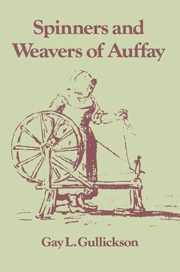 The Spinners and Weavers of Auffay
The Spinners and Weavers of Auffay Book contents
- Frontmatter
- Contents
- Preface
- 1 Introduction
- 2 The pays and the village
- 3 Proto-industrial theory and the pays de Caux
- 4 The golden age of spinning
- 5 Crisis and change in the Caux
- 6 The golden age of cottage weaving
- 7 Marriage and family in proto-industrial Auffay
- 8 Widowhood, remarriage, and the sexual division of labor
- 9 Unwed mothers and their children
- 10 Conclusions: the causes and consequences of proto-industrialization
- Appendix Vital statistics for Auffay
- Notes
- Bibliography
- Index
4 - The golden age of spinning
Published online by Cambridge University Press: 29 October 2009
- Frontmatter
- Contents
- Preface
- 1 Introduction
- 2 The pays and the village
- 3 Proto-industrial theory and the pays de Caux
- 4 The golden age of spinning
- 5 Crisis and change in the Caux
- 6 The golden age of cottage weaving
- 7 Marriage and family in proto-industrial Auffay
- 8 Widowhood, remarriage, and the sexual division of labor
- 9 Unwed mothers and their children
- 10 Conclusions: the causes and consequences of proto-industrialization
- Appendix Vital statistics for Auffay
- Notes
- Bibliography
- Index
Summary
When Delarue and his fellow merchants began to put cotton out into the Caux for spinning and weaving, their efforts were eagerly embraced by the peasants and villagers, much to the dismay of the wool merchants and wealthy laboureurs who feared the loss of their work force to what they regarded as the “soft occupation” (molle occupation) of carding and spinning cotton. The wool merchants' fears were, of course, well placed. Given a choice between wool and cotton, carders and spinners readily chose the cleaner, better-smelling, and more easily worked cotton. By the 1730s, the master drapers in such cities as Rouen and Bolbec were having difficulty recruiting spinners despite their decision to increase wages, and, by the 1760s, the industry was in a full-scale decline. Wool and cotton spinning competed directly in a way that spinning and agricultural work did not, however, and the fears of the laboureurs were not as well founded as those of the wool merchants. Throughout the eighteenth century, rural workers alternated spinning and weaving with agriculture on a seasonal basis, and, in the nonharvest season, agriculture employed only men and the cotton industry employed primarily women.
Most of the cotton fabric produced in the Caux was woven with linen warps and was called siamoise.
- Type
- Chapter
- Information
- The Spinners and Weavers of AuffayRural Industry and the Sexual Division of Labor in a French Village, pp. 68 - 85Publisher: Cambridge University PressPrint publication year: 1986
- 1
- Cited by


